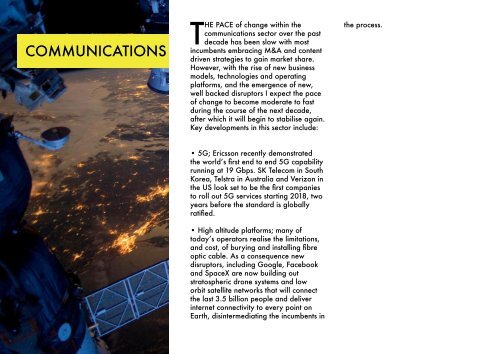311 Institute - The Future of Insurance 2020 &Beyond
You also want an ePaper? Increase the reach of your titles
YUMPU automatically turns print PDFs into web optimized ePapers that Google loves.
COMMUNICATIONS<br />
THE PACE <strong>of</strong> change within the<br />
communications sector over the past<br />
decade has been slow with most<br />
incumbents embracing M&A and content<br />
driven strategies to gain market share.<br />
However, with the rise <strong>of</strong> new business<br />
models, technologies and operating<br />
platforms, and the emergence <strong>of</strong> new,<br />
well backed disruptors I expect the pace<br />
<strong>of</strong> change to become moderate to fast<br />
during the course <strong>of</strong> the next decade,<br />
after which it will begin to stabilise again.<br />
Key developments in this sector include:<br />
the process.<br />
• 5G; Ericsson recently demonstrated<br />
the world’s first end to end 5G capability<br />
running at 19 Gbps. SK Telecom in South<br />
Korea, Telstra in Australia and Verizon in<br />
the US look set to be the first companies<br />
to roll out 5G services starting 2018, two<br />
years before the standard is globally<br />
ratified.<br />
• High altitude platforms; many <strong>of</strong><br />
today’s operators realise the limitations,<br />
and cost, <strong>of</strong> burying and installing fibre<br />
optic cable. As a consequence new<br />
disruptors, including Google, Facebook<br />
and SpaceX are now building out<br />
stratospheric drone systems and low<br />
orbit satellite networks that will connect<br />
the last 3.5 billion people and deliver<br />
internet connectivity to every point on<br />
Earth, disintermediating the incumbents in





